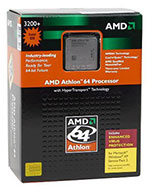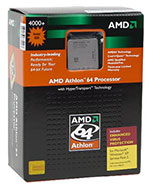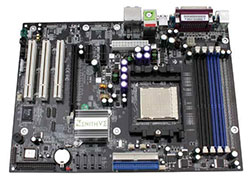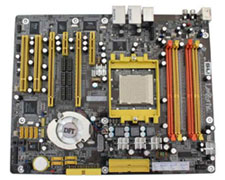Buyer's Guide: Mid-Range to High-End, May 2005
by Jarred Walton on May 23, 2005 5:30 PM EST- Posted in
- Guides
AMD Recommendations
AMD Processors
We covered the major differences between all of the currently shipping processor cores recently, and if you're not familiar with the various models, we would suggest that you give that a read. AMD arguably provides the best computing experience, both at the low end, the high end, and everything in between. However, their processor naming scheme can get a bit confusing, and especially the less experienced shoppers could end up with the wrong processor if they simply went by model numbers. There are no less than six currently shipping Athlon 64 3200+ chips, but we're only recommending one or two of those at present. Make sure that you get the right one!AMD Mid-Range Recommendation
Processor: Athlon 64 3200+ 90nm (Retail) - Winchester core
Price: $190 Shipped
The 3200+ remains to be the best option for socket 939, if you're trying to cut costs, yet still maintain a reasonable performance level. 2.0 GHz makes it 11% faster than the 3000+ and 9% slower than the 3500+. Although, the Winchester/Venice cores actually outperform Newcastle slightly clock for clock, so the 3500+ Newcastle may only be a few percent faster in certain applications (games, mostly). The 3000+ costs $146, and overclockers may be tempted to go that route rather than spend the extra $44. If you get a good motherboard and RAM for overclocking, the 3000+ may actually reach 2.5+ GHz, but it will require a 280+ MHz CPU bus speed compared to 250+ MHz for the 3200+. Depending on your overclocking skill, the 3200+ will probably get you farther than the 3000+. If you want to add SSE3 support, the Venice [RTPE: ADA3200BPBOX] cores cost an additional $20 relative to their Winchester [RTPE: ADA3200BIBOX] counterparts. SSE3 might help in certain encoding applications, and $20 isn't a major price difference, so it's definitely worth a thought. For now, we'll save the money for use elsewhere.
AMD High-End Recommendation
Processor: Athlon 64 4000+ 90nm (Retail) - San Diego core
Price: $507 Shipped
While the FX-55 remains the top-performing 939 part, we expect the new 90nm 4000+ [RTPE: ADA4000BNBOX] to give it a run for the money, particularly with overclocking. You may not be able to find the retail chips on sale right now, in which case, an OEM CPU is an option - overclockers are probably going to add a high-end HSF like the Zalman 7000 or Thermalright XP90 anyway. Some people feel that the retail chips are still a better choice for the improved warranty, and anecdotes of better overclocking with retail parts can be found on many forums. We're not sure if retail parts are actually better overclockers, but it's difficult to pass up on the 3-year warranty for a mere $18 increase. As a less expensive alternative that will still offer more performance than the 3200+ and 3500+, the new 3700+ [RTPE: ADA3700BNBOX] is definitely worth considering. The maximum overclocked speed is likely to be very similar to the 4000+, and it's quite a bit cheaper at $339. If you don't intend to overclock, of course, go with the fastest CPU that you can reasonably afford.
AMD Motherboards
If this were a budget guide, there would be many other options that we would consider, including boards using the VIA K8T890 and ATI Radeon Xpress 200 chipsets. For Mid-Range and above, nForce 3 and 4 are still our preferred choice. nForce 3 is on the way out, along with AGP, but if you have a good quality AGP card that you want to keep, it's a reasonable upgrade choice. For new systems, however, we recommend nForce 4 boards. The main difference between our Mid-Range and High End boards is the support (or lack thereof) for NVIDIA's SLI technology.AMD Mid-Range Recommendation
Motherboard: Chaintech VNF4 Ultra
Price: $89 Shipped
Considering the price difference (almost $20), we can't justify the additional cost for most of the competing nForce 4 Ultra motherboards. The Chaintech board lacks Firewire support, and the documentation and manual may not be the greatest, but it's still a high-performing board at a budget price. The Ultra model adds support for RAID and SATA2 as well as 1000 MHz HyperTransport, so we feel that it's worth the extra $2 relative to the nForce 4X model. Biostar, ECS, and Foxconn offer similarly equipped motherboards at a slightly higher price, but there's little reason to recommend their boards over the Chaintech - features and quality are very similar between these manufacturers in our experience, so we'll go with whatever's cheapest.
If you want additional features, ASUS, DFI, Gigabyte, MSI, and a few others make more expensive boards, and they certainly aren't a bad choice. DFI's Ultra board in particular is interesting, as it includes two physical PCIe X16 slots. While DFI doesn't ship an SLI connector and it may or may not be possible to mod the Ultra chip into an SLI chip, the board can still run dual graphics cards for multi-monitor support. DFI's boards also offer improved voltage ranges, which can help the overclockers, especially with RAM like the OCZ VX. Higher voltages mean more heat, which generally means more noise, so it's not something that everyone will appreciate. Still, most of these boards are at least $40 more than the Chaintech, so unless you really want the additional features, it's not worth the money. The nicer boards are also very close in price to some of the SLI boards, so at that point, you may as well go all the way to our High-End recommendation.
AMD High-End Recommendation
Motherboard: DFI LANPARTY UT nF4 SLI-DR
Price: $177 Shipped
For the high-performance enthusiast, SLI is the current crème de la crème, so an SLI motherboard is a must. The DFI Platinum board was co-winner of our Gold Editor's Choice award, and the differences between the UT and the "full version" are relatively minor. The UT doesn't include quite as many accessories, and the main omission is the front panel box and 5.1 audio instead of 7.1 audio; it also costs about $20 less. We don't feel that either of those features is really necessary, so we stuck with the standard model. The included Karajan sound module actually does quite well, so we don't see much need to purchase an add-in sound card for most users. The one issue worth mentioning on the DFI boards is that running with ultra-high voltages (using the 3.5V jumper) seems to cause some problems. That's only a concern for OCZ VX and Mushkin Redline users, really, and if you keep the voltage at stock you should be fine.
Honestly, all four SLI motherboards that we tested in our SLI Roundup (ASUS A8N Deluxe, Gigabyte GA-K8NXP-SLI, DFI LanParty SLI-DR, and MSI K8N Neo 4 Platinum SLI) are decent. The MSI board offers some great features, including the Sound Blaster 24-bit Live onboard audio. Unfortunately, we have recently discovered some performance issues when using the board with 90nm processors, so until MSI can release a BIOS update that addresses the issue, we would avoid the board. ASUS separates the two X16 slots by a larger margin, which should offer slightly better cooling for the top slot. However, it's a non-standard layout, and that could present problems in the future. We've already covered DFI, and Gigabyte has their "everything plus the kitchen sink" design. All four manufacturers are now offering "lite" versions of their SLI boards with reduced feature sets and prices, and in many cases, the missing features won't be missed. You can see the full list of SLI motherboards in our Pricing Engine. EPoX and Biostar also make SLI boards now, but we have not tested them, so we really can't comment on them other than to say they exist.
Update: After this Guide was initially written, it came to light that the MSI boards are having problems with 90nm parts. The MSI Neo4 SLI was our original high-end pick, but we changed that out after the new information. Sorry for the confusion!














60 Comments
View All Comments
PotterVilla - Wednesday, December 28, 2005 - link
Hello,I've not been able to find a XFX, MSI, or eVGA 6800GT graphics card at new egg (I'm not really looking to buy, just being wishful) and I also saw that the 6800XT is only $170. The 7800GT is more in your ballpark of $345 a card. Would ether of these cards be an upgrade, and has their price gone down that much ($175) in only about seven months?
Thank you.
jonp - Friday, August 26, 2005 - link
i wonder about the hp 1905fp recommend for the mid-range non-gaming display. there are considerable comments here and elsewhere about the poor analog (d-sub 15 pin) performance ie image quality. the Genesis gm-5321 controller chip is no longer shown on their web site and the datasheets are no longer available as well. (one wonders how much longer the 1905fp will even be available?) the dvi interface might be great, but there are some of us who connect their display through a kvm that only handles analog signals--so dvi performance is of little interest. i think we need a new monitor review and new pick for the non-gaming monitor recommendation. we depend on Anandtech for solid testing and non-subjective analysis to guide us in our quest for the best value. it is clear that we need new help in this area.JarredWalton - Thursday, June 16, 2005 - link
56 - not usually on NVIDIA nF3/4 or Intel chipsets. That's only an issue with secondary SATA controllers (VIA, SiS, Silicon Image, etc.) But still, never hurts to have that $8 part around just in case!mhallang - Wednesday, June 15, 2005 - link
Another reason to get a floppy drive is to install Win XP on a SATA drive. Maybe SP2 is different, and I would bet there's another way around it; but my experience was that I needed a floppy with the SATA drivers during the install process for XP.JarredWalton - Monday, June 13, 2005 - link
54 - Oh, I'd stay far away from XP64 for SLI. Raw doesn't begin to describe it, IMO. Longhorn is when I'll actually consider switching to a 64-bit OS.GreedyBumps - Thursday, June 9, 2005 - link
I built this system with all major components that are in this guide and cannot get SLI to work. Both cards work great individually but when I try to but them both in in SLI mode screen goes black after the black windows loading screen. I have tried all the driver / bios updates for everything I could find and still no dice.One issue could be that I installed Windows x64 professional - maybe some drivers are still too raw.
Also - the SLI jumpers on this DFI Lanparty board are a complete pain. They are tough to pull out and there are 6 of them. When you are trying to get SLI to work it is absolute nightmare to keep switching between SLI and Normal jumper cable settings.
JarredWalton - Wednesday, June 1, 2005 - link
52 - I got the information from Wesley. Basically, there is a higher number of RMA for motherboards and RAM when voltages above 3.3V are used. (Not too surprising, really, as higher V = higher heat.) 3.3V and below are fine, but there is a jumper to allow up to 4.0V. If you use that jumper, it causes problems. That's my understanding. In other words, don't plan on running OCZ VX at 3.7V with no active cooling. :)hgkfahgsa - Wednesday, June 1, 2005 - link
Jarred, could you elaborate on the problems with high voltages with the DFI cards? Is there any chance of the problems being resolved, does 3.3 volts work? etc... Thanks.JarredWalton - Friday, May 27, 2005 - link
50 - I know there are some Turtle Beach cards with S/PDIF in and out connections. M-Audio also has some, i.e. the Delta and Audiophile. Which one you want depends on the use. Most only have optical *OR* coaxial (RCA). I think many of the models with external boxes have both. If you were interested in an expensive, "everything" solution, there's the Audigy 4 Pro, but that's $280 or so, and I can't vouch for the actual quality as a whole.Honestly, I'm not a demanding audio person. If you want more advice on audio, I'm sure there are people in our forums that can provide better advice for "pro level" cards. You may as well ask me for advice on cars while you're at it! (Get something cheap and reliable!) ;-)
devslash - Friday, May 27, 2005 - link
how important is capability of S/PDIF input. i dont see many motherboards that have this on-board.isn't it important/good to have it, so DVD's audio
can be directly fed into the on-board sound system?
can you recommend a good board w/ S/PDIF input?